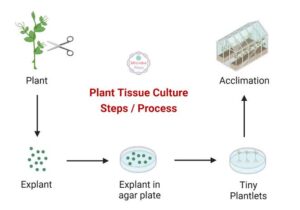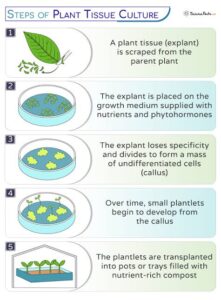Back to: Botany 400 Level
My ever-curious Afrilearn botanist, how you dey this fine day? E sweet me say you show face again for this learning journey! You be true learner wey no dey tire, and today matter go really open your eyes to one scientific magic wey dey happen quietly inside labs across Nigeria and the world. The topic we wan talk about na Principles of Plant Tissue Culture — something wey dey help us grow plenty healthy plants from just one small piece!
Principles of plant tissue culture
Picture this: A farmer get one very sweet and disease-free pineapple, and he wan grow hundreds more just like am. Instead of planting and waiting year after year, science don bring a smarter way — plant tissue culture. This method dey allow scientists grow thousands of identical plants from just a tiny tissue or even a single cell. Na like cloning, but for plants! It’s clean, fast, and super useful for agriculture, research, and even medicine. Make we talk how e work.

What is Plant Tissue Culture?
Plant tissue culture na the process of growing new plants from small pieces (called explants) like leaf, stem, or root tissues, inside a sterile laboratory environment. The idea na say every living plant cell get the ability to develop into a whole new plant if you give am the right condition — we call this ability totipotency.
Principles Behind Tissue Culture
- Totipotency
This one na the foundation. It means every plant cell, no matter how small, fit grow into a full plant if you give it the correct nutrients, hormones, and environment.
- Aseptic Conditions
Everything must be sterile — the tools, containers, and explants. Even small germs like bacteria or fungi fit spoil the whole culture. That’s why lab workers dey wear gloves, use alcohol, and work inside clean benches.
- Nutrient Medium
The plant piece no go grow just like that — it needs food. The explant is placed inside a special gel-like substance (often called Murashige and Skoog medium) that contains water, sugars, minerals, and plant hormones.
- Plant Growth Regulators (PGRs)
These na like plant vitamins. For example:
- Auxins help in root development.

- Cytokinins encourage shoot formation. The ratio of these hormones go determine wetin the tissue becomes — root, shoot, or even just more cells.
- Controlled Environment
Light, temperature, and humidity inside the culture room must be steady. For instance, most cultures need about 25°C and 16 hours of light per day. - Subculturing
As the tissue grows, it is divided and transferred into fresh medium to multiply it further. This helps to produce hundreds or even thousands of plants from one tiny piece.
In Nigeria, plant tissue culture dey used to mass-produce clean and disease-free banana and plantain seedlings. A farmer wey normally fit plant only 50 suckers, fit get 5,000 clean ones from tissue culture labs. This means better harvest, less pest wahala, and more money.
Summary
- Plant tissue culture is the science of growing new plants from small tissues in a sterile lab environment.
- It is based on the principle of totipotency, with sterile conditions, nutrient-rich media, and plant hormones playing key roles.
- It helps produce many identical, healthy plants quickly and is useful in agriculture, conservation, and research.
Evaluation
- What is totipotency?
- Why is sterility important in tissue culture?
- Name two plant growth regulators used in tissue culture.
- How can plant tissue culture help Nigerian farmers?
This one wey you dey understand the core principles of tissue culture, e clear say you dey prepare to use science solve big agricultural problems for Africa. Continue to dey grow your mind — you go soon dey lead your own plant biotech lab! Afrilearn dey your back as always. Let’s keep it moving!
